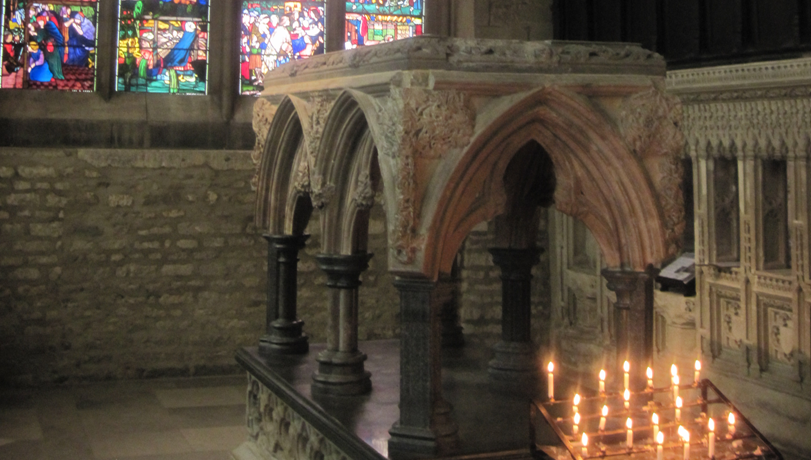Pilgrim's cross, carved into rock inside St. Ninian's Cave.
Ninian often went there to pray alone in retreat.
Saint Ninian, Known as the first apostle to the Picts, was born in the 360s in the Galloway area, just north of Hadrian's wall, and therefore outside of Roman jurisdiction. he was born the son of a minor British king, but devoted his time to reading and studying the scriptures, consistently educating himself. Christ's choosing of Peter as the "rock I will build my church" upon particularly grasped Ninian. and in an effort to continue his education he set out across Britain and Gaul where he came to Rome. There he pursued his education with the pope Damasus.
But Damasus's successor to the papacy, Siricus after learning that Scotland had not yet been exposed to the gospel, consecrated Ninian, sending him to be their missionary and bishop. On his way back, Ninian stopped once again in Gaul where he met St. Martin of Tours. As he reached his missionary diocese he began building Scotland first stone church at Whithern. And upon the news of St. Martin's death, Ninian dedicated it in honor of Tours' great bishop. The Church was made of white stone and would be known as the Candida Casa or Whitehouse for centuries to come. It came to be the center of ecclesiastical training for Scotland, northern England, and Ninian missions in Ireland, and remained so for a few centuries. But it's importance dwindled as missions in Ireland and Scotland came after Ninian. Ninian is attributed for the conversion of the southern Picts, Scotland's Britons, and some of Irish. He set up dioceses, establishing monasteries and churches and turned Whithern into a great center of Christian learning. Ninian died in the fifth century, and his relics were kept enshrined in the Candida Casa at Whithern until the reformation, when cathedrals were pulled down and art destroyed by Christian pretenders. His cult has been restored in the Anglican Communion and many churches in the Scottish Episcopal Church have been dedicated to him, including the cathedral at Perth.
Ninian remains important to us today for his missionary zeal; his willingness to travel to some of Scotland's unforgiving peoples and joyfully bring them the good news of Christ. The Church must must continue today, Ninian's work to bring the faith to new lands and maybe more importantly to re-evangelize in lands like Scotland, or England, France, the United States and may other countries that have known Christ for a long time but that have lapsed in the faith.
OGOD, who by the preaching of thy blessed servant Saint Ninian didst cause the light of the Gospel to shine in Scotland; Grant, we beseech thee, that having his life and labours in remembrance, we may shew forth our thankfulness unto thee for the same by following the example of his zeal and patience in continuing to spread this light; through Jesus Christ our Lord.Amen.
References from St. Columba and Iona, the Early History of the Christian Church in Scotland, by Alphons Bellesheim.


hey
ReplyDeleteI'd just like to say that I think it's amazing that you take the time to research all of this and write about it. I admire you now :)
Thanks so much, its the history I enjoy most, and that makes it fun to write about.
ReplyDelete-Max Woolley
Great post, Max. Thanks for sharing your passion and knowledge.
ReplyDeleteThose darned reformers!